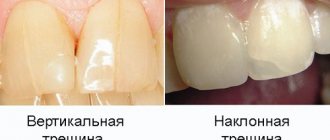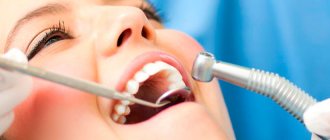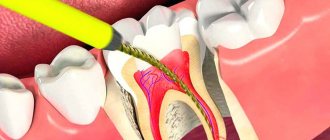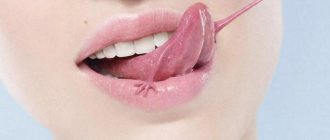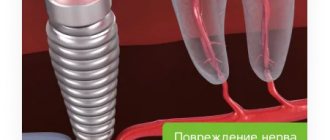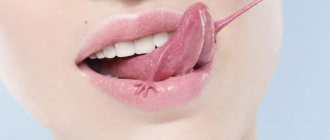Why is temporary filling needed?
The need to use filling material is determined by the dentist. The installation of a temporary filling is prescribed by a doctor in the following cases:
- Carrying out diagnostics. When treating a patient with deep caries, a specialist is not always able to determine the extent of tissue damage. The doctor cleans the tooth cavity and places filling material. If the neurovascular bundle is not inflamed, then after the procedure the person will not experience pain. If the dental nerve and surrounding tissues are damaged, preliminary treatment will be required.
- Removal of the neurovascular bundle. In some cases, nerve sacrifice is required before removal. To do this, the dentist puts a specialized paste into the tooth cavity. After a certain period of time, the specialist removes the pulp and fills the tooth cavity with permanent filling material.
- Dental prosthetics. The dentist prepares teeth for prosthetics. To ensure that the root canals are protected from food and pathogenic bacteria during manufacturing, the specialist places a temporary filling material into the tooth cavity.
- Treatment of diseases. After treatment, the dentist places medications into the tooth cavity. After a certain period of time, the specialist removes the temporary filling and installs a permanent filling.
How to solve a problem
Eliminating the problem depends on the reasons that caused it. If the problem is related to the installation of a temporary filling, then after it is replaced with a permanent one, the unpleasant taste in the mouth will disappear. In case of poor-quality dental treatment, the only way out of the situation is to get rid of the filling and install a new one.
Ceramic tabs almost never give off an aftertaste
You can get rid of the unpleasant taste in your mouth by rinsing with mint infusion or special pharmaceutical solutions.
But if this does not help and the taste of the medicine only intensifies, you need to visit a doctor to determine the cause of the problem.
Material requirements
To install a temporary filling, a specialized material is used that can be easily removed by the dentist if necessary. The composition for temporary filling must meet the following requirements:
- X-ray resistant. To check the correctness of the filling, the dentist prescribes an x-ray examination. The image allows you to timely identify the presence of cracks in the filling material and eliminate them.
- Good grip on the surface. It is necessary to exclude the formation of microcracks or incomplete adhesion of the material to the tooth tissue. Violation of this rule may result in medication entering the oral cavity.
- Elasticity. The material should easily fill the pores formed in the tooth tissue.
- Strength. The material is installed by the dentist for a certain period of time. When eating, the filling is subjected to high stress. In this regard, the seal must be resistant to mechanical damage.
- Harmlessness. The filling should not cause allergic reactions or negatively affect human health.
- Easy to remove. At your follow-up appointment, the doctor quickly removes the temporary filling.
A mandatory requirement for temporary material is a high curing speed. The filling completely hardens in 2 – 3 hours.
Types of temporary filling depending on the material
The material used to install a temporary filling is non-toxic, environmentally friendly and does not pose any danger to the body. At the same time, it is quite plastic, can occupy any volume, and has the property of rapid drying.
Depending on the practical application, a temporary filling may contain different compositions, in particular:
- Artificial dentin.
It is the most common substance for making temporary fillings. It contains zinc oxide and kaolin. For quick hardening (up to 3 minutes) mix with a small amount of water.
- Dentin pastes.
Slightly increased hardening time of the substance due to the fact that essential oils are used instead of water (as in the case of artificial dentin).
- If there is a need for temporary filling of dental canals, a mixture of Karyosan is used.
- For pain relief
and relieving the inflammatory process, solutions based on zinc-evengel cement are effectively used.
What can happen after installing a temporary filling?
In some cases, patients experience pain after placing temporary filling material into the tooth cavity. Mild pain during the first 5 days after the intervention is considered normal. If pain intensifies, you should immediately consult a doctor. Violation of this rule can lead to the development of various diseases and tooth loss.
It is normal to have a smell or taste of medication in the mouth after the procedure. The sudden appearance of a strong smell or taste of medicines indicates depressurization of the filling and leaching of medicines with saliva from the tooth cavity. Some drugs, if they enter the oral cavity, can have a negative effect on the human body. If such signs appear, you should immediately contact a specialist.
Swelling of the gums, darkening of tooth enamel, and the appearance of bad breath indicate the development of diseases. If symptoms appear, you should contact your dentist immediately. The doctor will remove the filling material and carry out diagnostic measures. You may need to contact your dentist if the filling breaks. Failure to visit a specialist in a timely manner will result in food particles and bacteria entering the tooth cavity.
Causes
This situation appears under the influence of various factors. Common causes of burning, unpleasant taste and bitterness in the mouth:
- Low quality medicines. Some specialists, in order to reduce the cost of their services, use cheap materials and products that have an unpleasant taste. Therefore, it is necessary to first check with a specialist what materials he will use in his work.
High-quality medicines show less symptoms
- Allergic reaction. Allergies to mucous tissues can occur to medications and filling materials. A person feels swelling of the mucous tissues, discomfort and that the mouth smells like medicine. You can only figure out what caused this problem with the help of a qualified specialist. The doctor will identify the allergen and take measures to eliminate it. You should not self-medicate with antihistamines. Because if a reaction occurs to the filling material, the problem will go away on its own after the filling is removed.
- Sores on mucous tissues. Microtraumas often occur in the oral cavity during therapeutic procedures. An infection gets into the wounds and the inflammatory process and stomatitis begin to develop. With herpetic stomatitis, bubbles with liquid appear, which increase in size, burst and erosions appear in their place. There is a burning sensation and pain in the oral cavity.
- An unpleasant aftertaste of medicine in the mouth after dental treatment and bitterness occur if the installed permanent filling does not cover the tooth airtightly. In such a situation, other unpleasant symptoms may occur: tooth sensitivity and pain.
- Sometimes the problem appears when a temporary filling is installed. Most medications and antiseptics used in dentistry have a specific and unpleasant taste. Therefore, it is normal to feel a taste of the medicine for several days after dental filling.
Sometimes an unpleasant aftertaste of medications may appear several years after dental treatment.
Amalgam filling adds a metallic taste
This happens when a filling cracks or comes off. In this case, over time, toothache will appear, and the tooth itself will decay. Therefore, you need to regularly visit the dentist in order to promptly identify dental problems and eliminate them.
How long can you walk with a temporary filling?
The material used for temporary filling is highly durable. The filling does not break down for a long time. The specialist determines the period of wearing temporary filling material based on the nature and degree of neglect of the disease. The duration of wearing the filling is individual for each patient.
At the end of the established period, the person must immediately contact a specialist. An increase in the time period can lead to the development of diseases. In some cases, the filling may crumble at the end of its period, and the drug will negatively affect the patient’s body.
Is it possible to fight the unpleasant odor from under the crown?
Since the unpleasant smell is caused by rotting processes, while they continue, it is impossible to get rid of the smell. You can only reduce it a little during treatment. They can help:
- Mouth rinses. To do this, you can use special antiseptic solutions that your doctor will recommend. Decoctions of medicinal herbs, such as chamomile or oak, are also suitable.
- Professional hygiene. The denture must be removed and cleaned. If the crown was installed to treat partial edentia, we recommend professional cleaning.
- Careful daily oral hygiene. In addition to a toothbrush and toothpaste, you can use special devices. You can completely clean the oral cavity, including in hard-to-reach places, using an irrigator. The device delivers a stream of air under pressure, which completely cleans out any remaining food. To care for crowns and implants, special brushes are used - interproximal, beam. You can clean the spaces between teeth using floss and floss.
Functions of a temporary filling
First of all, a temporary filling is installed to protect the damaged tooth in the period of time between its treatments. It is created from a special material. It differs from the mass composition of a standard permanent filling. The temporary filling contains certain components that allow the mass to hold firmly in the tooth cavity, but if necessary, the filling can be easily removed. Unlike a temporary filling, a permanent filling is intended to be worn for several years, unless the filling is damaged or falls out on its own.
Important ! If all necessary rules and recommendations are followed, the filling will serve the patient for a long time.
A temporary filling is necessary to protect the tooth during treatment
Symptoms of tooth decay
The process of rotting under the crown proceeds unnoticed and painlessly, because the nerves have been removed. Painful sensations appear later, when the inflammatory process spreads to the gums, and this is a step towards the loss of “neighboring” completely healthy dental units. Immediate consultation with a dentist is necessary if you notice:
- the appearance of a gap between the crown and gum;
- small particles of food getting under the denture;
- an unpleasant odor that reappears even after comprehensive cleaning and rinsing with an antiseptic;
- blackening of the base of the tooth.
Things to remember:
Tooth destruction is irreversible; even a highly qualified specialist cannot restore its natural integrity. And a timely visit to the dentist will certainly help to avoid complications.
How to get rid of bad breath
Some sensitive issues are not usually discussed even with close relatives. People tend to turn a blind eye and ignore them for a long time, especially if the solution requires consulting a specialist. In such a situation, many choose the path of least resistance - folk recipes and various remedies that can be used at home. As a rule, they are ineffective, but such a choice does not require much effort and suits the person until the problems reach frightening proportions.
The scenario described above is more than typical for the symptom discussed in this publication. Bad breath is not something to discuss. The rules of good manners do not allow others to point out the problem, and the person himself prefers to think that it is not so big.
In everyday life, this symptom of chronic somatic diseases or dental pathology is often described with the vague formulation “bad breath.” Doctors and dentists use the more correct and unambiguous term “halitosis.” Breath with a “smell” most often indicates the development of certain diseases. It is not necessary to discuss the situation with loved ones, but if bad breath appears, it is extremely important to undergo a diagnosis that will reveal the true causes of halitosis.
Causes
Not all causes of halitosis are a cause for concern. In a certain percentage of cases, it’s all about the banal consumption of certain foods or drinks that have pronounced aromatic properties. An example would be garlic, onions or fish - foods with a specific aroma. Exogenous causes include smoking. Tobacco often causes bad breath, which the smoker himself does not even notice. But these reasons are obvious, and it’s easy to fight them. It is more difficult (and more important!) to solve a problem that has no obvious causes.
In order to get rid of bad breath once and for all, which has been bothering you for a long time and is not associated with exogenous causes, it is important to find out what causes its appearance. Endogenous (internal) causes can be divided into two categories.
The first category is diseases of the oral cavity. It is oral disease that is the root of the problem in the vast majority of people with halitosis. Dental diseases that can lead to bad breath are discussed in more detail in the next section of the publication.
The second group of causes is formed by chronic diseases of the stomach, other parts and organs of the digestive system, and diseases of the endocrine organs. The greatest danger is diabetes mellitus, both type 1 and type 2. This endocrine pathology is characterized by the appearance of an “acetone” odor. It is caused by metabolic disorders: the patient’s body increases the formation of ketone bodies (organic compounds), which are excreted through the lungs and give the breath a specific “acetone” smell.
Parents should be wary of this symptom (smell of acetone). If a child develops a symptom, you should immediately consult a specialist and undergo an examination, a mandatory element of which is a glucose tolerance test and a blood sugar test.
Note that in rare cases, the unpleasant odor of acetone is associated with dietary habits. In recent years, the so-called ketone diet, which requires maximum restriction of carbohydrate intake, has become very popular. Its goal is to transition the body into a state of acidosis, in which there is an increased formation of ketone bodies. Because these organic substances are partially eliminated through the lungs, followers of the ketone diet often face the problem of bad breath.
Halitosis in dental pathology
Gastrointestinal diseases (gastritis, stomach ulcers), diabetes mellitus or the ketone diet are conditions that people are generally well aware of. The only exception is undiagnosed diabetes, so if the smell of acetone appears, it is extremely important to promptly seek qualified help.
If bad breath appears against the background of “complete well-being,” its causes should be sought in dental pathology. It is very important to understand that oral diseases are the main causes of halitosis in people without chronic endocrine or somatic pathology. If you are interested in the question of how to get rid of bad breath, carefully study this section of the publication. This way you can avoid common mistakes, forget about the problem forever and, most importantly, keep your teeth intact and healthy.
In diseases of the oral cavity (often they are not diagnosed, that is, the person may not be aware of the problem), the unpleasant odor has a specific, slightly “putrid” character. At first, a person notices the symptom, mainly after sleep, before carrying out morning hygiene procedures. Then the problem of bad breath becomes a constant companion, which causes serious concern.
Caries
What diseases provoke the appearance of halitosis? In the first place is caries. Carious tooth damage is accompanied by the development of pathogenic microflora. Bacteria produce toxins that cause inflammation in the oral cavity. In addition, bacteria emit gaseous substances, which themselves have an unpleasant odor.
The degree of carious lesion directly affects the severity of halitosis. The deeper the microorganisms penetrate into the tooth, the stronger the unpleasant odor. The problem can only be solved by complete removal of the affected tissue with restoration of the defective tooth.
The only right decision is to seek help from a specialist without any extra thought or doubt. Make an appointment with your dentist, otherwise the tooth will continue to decay. Once a critical amount of living tissue has been destroyed, restoring the tooth will require expensive orthopedic treatment.
Periodontitis, fistula in the gum
Purulent inflammation around the root apex is the result of untreated caries and pulpitis. An apical abscess can manifest itself as a symptom such as the formation of a fistula on the gum. A fistula is the external opening of a canal connecting a cyst to the oral cavity. Through the fistula, pus is released, which is accompanied by the appearance of a characteristic unpleasant odor.
Poor hygiene
Are there other causes of halitosis besides tooth decay? Undoubtedly. Bad breath can be the result of poor oral care. If a person brushes their teeth sporadically, or does it too quickly or not thoroughly enough, a bacterial film forms on the surface of the teeth. Over time, this soft film, which can be easily removed with a regular brush, becomes saturated with mineral salts. This forms hard stone on the teeth, which can no longer be removed with a brush.
The basis of dental plaque is bacteria, which release toxins and gaseous substances, causing inflammation of the oral mucosa. Due to these processes, the breath acquires an unpleasant odor.
Gingivitis, periodontitis
Hard dental plaque is a harbinger of dental caries and a number of other oral diseases. If you do nothing, sooner or later you will face more serious problems than halitosis. Many people begin to notice that their gums bleed during daily brushing. These are the first symptoms of gingivitis, in which an inflammatory process develops in the gum mucosa.
Gingivitis left untreated (or treated with home remedies that are ineffective) leads to the development of periodontitis, an oral disease that poses a real risk of tooth loss. At this point, many remember that it all started with poor hygiene and bad breath, and the problem was easily solved by hygienic teeth cleaning in the dental office.
How to get rid of bad breath?
Even today, in the age of maximum availability of information about various symptoms, their causes and treatment methods, many people continue to pose the question differently: how to get rid of bad breath at home? Is this possible, and if not, why?
Fresh breath, which is actively advertised by manufacturers of toothpastes and chewing gums, is an indicator of good hygiene and overall health of the oral cavity and teeth. Breathing is a kind of litmus test that allows us to understand how healthy we are and how attentive we are to personal hygiene.
Bad breath is a red flag and an indicator of serious problems. Problems not only with hygiene, but with oral health. It is possible to mask halitosis by chewing gum or regularly rinsing the mouth with special solutions, but this will not solve the problem.
How to eliminate bad breath if it is caused by stone formation with activation of pathogenic microflora? Stone is a mineralized plaque that is firmly fixed to the enamel. It is not possible to remove the stone yourself. This can only be done by a dentist using special equipment. Ultrasonic cleaning is used to remove tartar. Another technology for removing deposits is Air Flow.
Professional teeth cleaning is the most effective means of preventing caries, periodontitis, gingivitis and other dental diseases!
For gingivitis, professional teeth cleaning to remove hard deposits is also a mandatory stage of treatment. After cleaning the teeth, anti-inflammatory therapy is prescribed for 10 days. The patient should rinse the mouth with antiseptic solutions several times a day. After rinsing, special dental gels with an anti-inflammatory effect are applied to the gums.
In case of periodontitis, the above stages of treatment do not lose their relevance, but teeth cleaning is complicated by the fact that it is necessary to remove stone from periodontal pockets. This is difficult to do; the treatment is carried out by a doctor with a narrow specialization - a periodontist. In addition to anti-inflammatory drugs, antibiotics are often prescribed.
How to remove bad breath caused by caries? If the cause of “stale breath” is caries, there is no need to talk about the effectiveness of any methods for use at home. Science has not yet known cases of self-healing from this disease. The person who finds a way to cure tooth decay without the help of a dentist should be awarded a Nobel Prize.
Caries treatment is carried out in a dental clinic. The dentist removes all tissues affected by the carious process. If this is not done, a source of infection will remain, which will lead to further decay and destruction of the tooth.
After removing the carious defect, the tooth is restored with a composite polymer (a filling is placed). If caries is complicated by the development of pulpitis or periodontitis, the stage of depulpation, sanitation and subsequent sealing of the canals is added to the treatment protocols. Depulpation with root canal sealing increases the duration and cost of treatment, but it is necessary if you want to save the tooth.
To cure caries quickly and without extra costs, contact your dentist when the first symptoms appear, or better yet, schedule a consultation every six months for a preventive examination and professional teeth cleaning.
Bad breath after caries treatment
Some patients develop bad breath after caries treatment. As a rule, bad breath is accompanied by another symptom - local pain in the area of the projection of the treated tooth or the formation of a fistula in the gum. The condition should be considered as a complication that indicates poor quality dental care.
The cause of post-filling pain is the re-development of the infectious process in the deep tissues. This is caused by incomplete removal of carious tissues or poor isolation of the tooth during filling or sealing of canals. In the first case, pathogenic microorganisms remain in the tooth, in the second, saliva and bacteria get under the filling, which become a source of secondary infection.
To remove bad breath in such a situation, you need to undergo repeated treatment with unfilling of the root canals and sanitization of the source of infection. To avoid complications, contact dental centers with a good reputation and trust your oral health to qualified, conscientious and experienced specialists.
Prevention
If there is no unpleasant odor, its occurrence can be easily prevented. High-quality and regular cleaning of the oral cavity is enough. After eating, it is important to remove the smallest particles of food from the interdental spaces. To do this, you need to use dental floss, and then clean the lingual and outer surfaces of the teeth with a good brush, preferably with stiff bristles.
People with orthopedic (crowns, bridges) or orthodontic (braces) structures, as well as anomalies in the location of teeth in the form of crowding, may require additional tools for personal hygiene. Dentists strongly recommend that such patients purchase an irrigator with special attachments that ideally cleans crowns, braces, narrow interdental spaces and gum pockets.
It is good practice to have your teeth professionally cleaned with Air Flow regularly at your dentist's office to help prevent plaque from forming. Once every six months you need to make an appointment for preventive examinations with a dentist to detect caries at an early stage.
To receive individual recommendations regarding solving the problem of “stale breath,” sign up for a consultation with a medical dentist (Moscow).
Stages of root canal treatment
Endodontic treatment is carried out in several stages, namely:
- Professional oral hygiene.
- Providing access to the channel.
- Removal of nerves and pulp.
- Mechanical and medicinal treatment of root canals.
- Temporary tooth filling.
- Permanent tooth filling and restoration of its shape.
If the essence and purpose of almost all stages are more or less clear, then not everyone knows why temporary tooth filling is necessary during endodontic treatment.
Further in the article we will tell you why temporary filling is performed, why a temporary filling is placed after root canal filling, what indications for this procedure exist and why a tooth may hurt after temporary filling.



